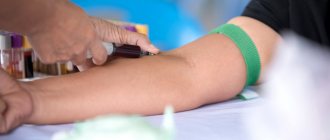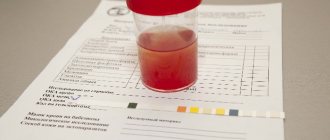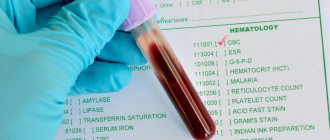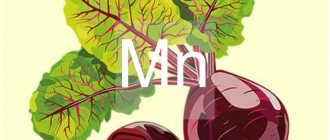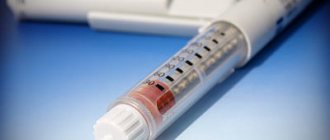The concept of general urine analysis includes the determination of its physicochemical and biochemical properties, as well as sediment microscopy. It is considered a classic method for diagnosing diseases of the kidneys and other organs, and is also prescribed during an annual preventive examination. Why take a urine test, what abnormalities in a person’s condition will it show?
- Inflammatory, autoimmune, metabolic, oncological diseases of the kidneys and urinary tract;
- Endocrine disorders - diabetes mellitus, hyperfunction of the parathyroid gland, Cushing's syndrome;
- Changes in the acid-base state of the body - acidosis and alkalosis;
- Dehydration (dehydration) with prolonged vomiting and diarrhea, fever, fasting;
- Gestosis in pregnant women, eclampsia;
- Poisoning with salts of heavy metals, phenol, aniline, ethylene glycol, poisonous mushrooms, snake venom, drugs, etc.;
- Other diseases - gout, myeloma, paroxysmal nocturnal hemoglobinuria, Fanconi syndrome, hemolytic anemia, obstructive jaundice, hepatitis, etc.
Also, its prescription is justified for dynamic monitoring of the effectiveness of treatment, monitoring the course of the disease and the occurrence of complications.
Data from a general urine test are always considered in conjunction with the symptoms of the disease and the results of other laboratory tests.
Ketonuria and its role in the body
Ketone bodies are a product of metabolic processes. They are presented in the form of acetone and acetoacetic acid. Acetone is toxic to the body and especially to the brain. For this reason, its concentration in the blood is minimal. At the same time, ketone bodies play a significant biological role in the human body. Due to their presence, energy balance is maintained throughout the human body.
Acetone bodies act as a kind of fuel for the kidneys, as well as muscle tissue. Ketones are thought to reduce fatty acid production. Their role is noticeably enhanced during human fasting, when the body lacks energy. Ketone bodies serve as the basic source of energy for the brain itself.
When a person develops a number of diseases, as well as for other reasons, the presence of acetone in the urine may be present in quantities significantly higher than normal. This pathology is called ketonuria.
What are ketone bodies?
Ketone bodies are substances produced by metabolism. They are formed from fats that break down in the liver. After which they enter the blood, and after passing through filtration, they completely disappear.
Ketones consist of the following compounds:
- acetone;
- acetoacetic acid;
- β – hydroxybutyric acid.
Since ketones are metabolic products containing acetone, their increase in urine is also called acetonuria.
Ketone bodies
Types of ketonuria
Ketonuria or acetonuria has several varieties. There are several criteria for classifying this disease. Depending on the cause of its occurrence, ketonuria is divided into physiological and pathological.
Physiological acetonuria is further divided into two subtypes:
- nutritional, which occurs due to energy starvation due to a lack of carbohydrates in the body and an excess of protein foods;
- emotional, arising due to constant stress and overwork.
The nutritional type of ketonuria is more often characteristic of children whose daily diet contains a small amount of carbohydrates. Emotional ketonuria occurs in people of any age. The main reason for this is severe stress. Physiological acetonuria is not associated with the development of pathology in the human body and is usually eliminated by normalizing nutrition and emotional state.
Pathological ketonuria is associated with the development of any serious disease in the body. The condition is divided into two subtypes:
- acetonuria in the presence of normoglycemia;
- acetonuria against the background of hyperglycemia.
In both cases, in addition to the concentration of ketones in urine, the blood sugar content is taken into account. In the first case, ketones are contained in the urine, but the blood glucose level is normal. Acetonuria with normoglycemia may indicate the presence of the following diseases in a person:
- cancer;
- fever;
- tuberculosis-type meningitis;
- scarlet fever.
Acetonuria with hyperglycemia (high blood sugar) often confirms the development of diabetes mellitus or hyperketonemic coma in a person.
A similar classification of ketonuria is used depending on the cause of its occurrence. According to it, the disease is divided into primary and secondary. Primary acetonuria is characteristic of diabetics, as well as people suffering from thyrotoxicosis or Itsenko-Cushing's disease.
Secondary acetonuria according to this classification occurs due to the influence of pathological processes not associated with a malfunction of the endocrine system. It appears when:
- fasting;
- protein diet;
- excessive physical activity;
- dysentery;
- pregnancy;
- infections (cystitis, scarlet fever);
- head injuries.
With all types of ketonuria, there is an excess of the normal content of ketones in urine.
Urine production and volume
The human body produces two main bioactive fluids: blood, which carries nutrients and oxygen to all organs and systems and takes waste products from them, and urine, which is responsible for removing “waste material” outside the body. Urine (urine) formation occurs in the kidneys. It is here that nephrons are located, special formations that filter the blood and synthesize urine, which is collected in the pelvis, then enters the bladder, and from there it is excreted outside the body.
This complex multi-step process is called diuresis. During the day, the body produces and excretes about 1.5-1.8 liters of urine. The rate of formation, composition, and amount of liquid depend both on the state of the body itself and the processes occurring in it, and on external conditions: ambient temperature, time of day, quantity and type of food and liquid consumed.
Deviations in the volume of urine produced from the norm are divided into several types:
- polyuria – characterized by an increase in the amount of urine excreted by the body; various kidney diseases, as well as types of diabetes, lead to this type of pathology;
- oliguria – decreased volume of daily urine;
- Anuria is a complete absence of urination, a sign of blockage of the urinary tract, kidney failure.
Urinalysis is an easy-to-perform procedure, while the information content of the results obtained is quite high and makes it possible to make an assumption about the development of a particular disease in the body, to choose the right direction and methodology for further examination. Taking this into account, doctors actively use the capabilities of this diagnostic method and prescribe a urine test:
- during preventive and mandatory medical examinations;
- to check the performance of the urinary system in order to identify existing diseases;
- for diagnosis and localization of the location of inflammatory processes occurring in the body;
- to assess the effectiveness of the prescribed treatment and monitor the resulting changes in the body.
For a more accurate diagnosis, the doctor writes out directions for laboratory tests in a comprehensive manner. Along with donating urine for laboratory testing, in most cases, patients also donate blood and feces. This makes it possible to identify abnormalities in the body’s functioning at an early stage. After all, as you know, coping with a disease at the initial stage is much easier than with advanced pathology.
Normal levels of ketone bodies in urine
In a healthy body, acetone bodies are completely absent in the urine. The presence of no more than 50 mg of ketones in urine per day is allowed. This amount of substances is not detected by diagnostic methods for recognizing acetone bodies. In this case, we can talk about the absence of pathological processes in the body.
Quantitative data ranging from 0 to 0.5 mmol/l are considered the norm for acetone content in human urine. Exceeding this indicator indicates the development of the following pathologies:
- 0.5 mmol/l - borderline state, indicating a mild form of ketonuria (a repeat analysis is performed to confirm or refute the preliminary diagnosis);
- 0.5-1.5 mmol/l - development of ketonemia;
- 1.5 mmol/L or more is a serious condition, indicating the development of life-threatening diabetic ketoacidosis.
Urine analysis according to Zimnitsky
Urine analysis according to Zimnitsky
is one of the ways to check the excretory function of the kidneys, which helps determine how correctly these organs are functioning and whether the patient is at risk of possible complications in the form of acute renal failure. This study is recommended in cases of certain diseases:
No special preparation is required for Zimnitsky's analysis. The patient does not need to limit himself in food and drink. Immediately before collecting biomaterial, it is recommended to exclude spicy dishes and foods that stain urine - beets, rhubarb - from the regular menu. For the study, you will have to stock up on a set of 8 clean jars, as well as a notepad for recording the volume of liquid consumed and the time for collecting the analysis in the next container. Every time before visiting the toilet, it is necessary to perform genital hygiene.
When examining urine, any detected deviations from established standards in the direction of exceeding them are considered to be pathology.
Improper functioning of the kidneys is also indicated by the presence of protein, epithelial cells, and bacteria in the urine. Don't panic and self-medicate. Only a specialist can correctly interpret the analysis results!
Sign up for a urine test
Make an appointment
Causes of ketonuria and its symptoms in children and adults
The reasons for the appearance of acetone in the urine in children and adults are similar. But at the same time, certain features of the phenomenon are noted in people of different ages and genders. In children, common causes of acetonuria are:
- hypothermia;
- diathesis;
- past infections;
- lack of enzymes;
- dysentery;
- uncontrolled use of antibiotics;
- starvation;
- excess consumption of fats and proteins;
- heredity;
- stressful situations;
- damage to the body by worms;
- excessive activity;
- elevated temperature.
In adults, the main causes of ketonuria include:
- excess proteins in the body and lack of carbohydrates;
- development of anemia;
- influenza and other viral infections;
- prolonged fasting;
- pregnancy;
- oncological diseases;
- excessive physical activity;
- development of diabetes mellitus.
Pregnancy is one of the physiological causes of acetonuria. An increased concentration of ketones in the urine of a pregnant woman is especially typical in the first trimester of pregnancy. At the same time, we cannot talk about the development of a pathological process in the body. It is enough for a woman to adjust her diet, and the acetone content in urine will return to normal in a few days.
The prolonged nature of ketonuria in pregnant women indicates the presence of problems with digestion and liver. Acetone is present in excess in urine also due to toxicosis. In late pregnancy, acetonuria is a sign of a woman developing gestational diabetes or thyrotoxicosis. Gestational diabetes develops only in pregnant women. One of the signs of the development of the disease is an excessive concentration of ketone bodies in the urine.
In adults, ketonuria is also possible due to excessive alcohol consumption and poisoning of the body with low-quality alcohol or heavy metals. Acetone in urine is typical for people with malignant tumors of the pituitary gland and adrenal glands. When you are sick, the body produces excess corticosteroids.
General symptoms characteristic of ketonuria include:
- feeling of dry mouth;
- acetone taste in the mouth;
- strong smell of acetone when urinating;
- poor appetite;
- the appearance of nausea and vomiting after eating;
- thirst;
- lethargy;
- increased fatigue;
- pale skin tone;
- increased body temperature (especially in children);
- headache;
- enlarged liver.
In particularly severe cases, symptoms may include:
- coma;
- severe poisoning of the body;
- dehydration;
- damage to the central nervous system.
Therapeutic diet for ketonuria
When treating the disease, the main emphasis is on adjusting the person’s diet. His daily menu should include the following dishes:
- vegetables;
- meat without fat (rabbit, turkey, beef);
- vegetable soups;
- porridge;
- nuts (walnuts or hazelnuts);
- green tea;
- low-fat fermented milk products;
- berry fruit drinks;
- lean fish;
- fruits other than citrus fruits.
A diet for acetonuria requires excluding the following dishes from the diet:
- offal;
- high fat dairy products;
- alcohol;
- fast food;
- any fried, canned or smoked food;
- coffee;
- mushrooms;
- fat meat;
- sweet;
- any types of citrus fruits;
- tomatoes.
Additionally, to remove acetone from the body, the patient must drink frequently. Water is consumed 4 times within an hour in small volumes. Drinking alkaline water without carbon, chamomile infusions and dried fruit compotes is beneficial. If necessary, the patient is given enemas consisting of a 2% solution of soda and water.
In severe forms of acetonuria, patients are given droppers based on the drugs “Regidron”, “Cerucal”. The latter is indicated in the presence of vomiting. It is recommended to cleanse the body by taking adsorbents, which include activated carbon and the drug “Sorbex”. For inflammation, Ketonal is additionally prescribed.
How to remove ketones from urine
To remove acetone from the body, an adequate drinking regimen is indicated to form sufficient diuresis. To do this, the patient needs to drink at least 2 liters of pure still water per day. But under the control of diuresis (the ratio of fluid drunk and excreted during the day). Diuresis must be monitored to prevent edema and increased blood pressure.
In addition, acetone can be removed using infusion therapy. For this purpose, the following solutions are introduced into the human body:
- solution Disol, Trisol, Acesol;
- "Regidron";
- saline solution (NaCl).

